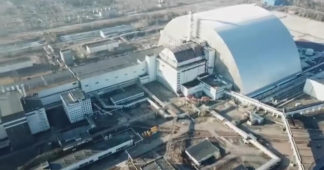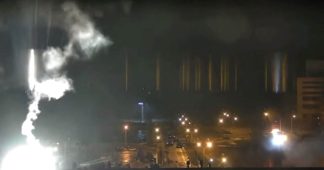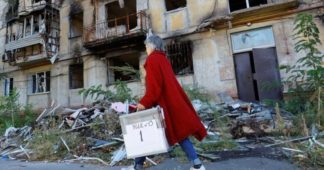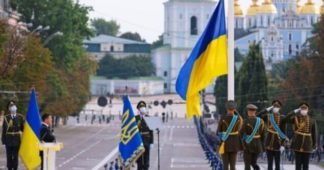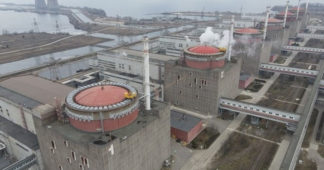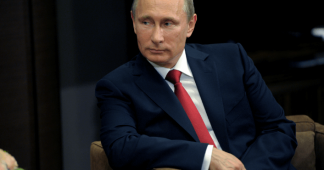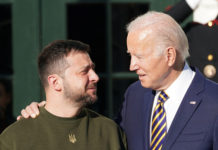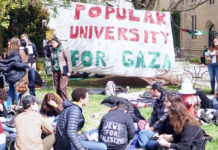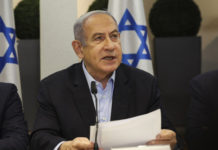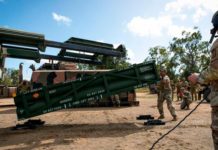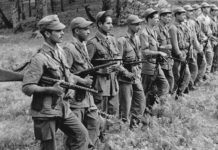By Dmitriy Kovalevich
December 6, 2022
In this monthly update for November, Dmitriy Kovalevich, special correspondent in Ukraine for New Cold War summarizes the events that lead to the current SMO and the events as they continue to unfold in the country. In this review, he examines the situation at the nuclear power plant in Zaporozhye, the strategic withdrawal of Russian troops from Kherson and the grim details of what befell the city following the entry of the Ukraine military, leading to another flurry of duplicitous anti-Russian propaganda by the Ukraine authorities and others. He also details the targeting of Ukraine’s energy transmission system, the disastrous economic and employment situation facing many workers and farmers. He finally looks at the efforts being made to draw the West into the conflict, and considers the increasing demands for a truce and negotiations in Ukraine, a country that is growing tired of war.
_______________________
In this monthly update for November 2022, Dmitriy Kovalevich special correspondent in Ukraine for New Cold War, reminds us of the events that lead to the current SMO, and the events as they continue to unfold in the country, including the situation at the nuclear power plant in Zaporozhye, the strategic withdrawal of Russian troops from Kherson and the grim details of what befell the city following the entry of the Ukraine military, leading to another flurry of duplicitous anti-Russian propaganda by the Ukraine authorities and others. He covers the targeting of Ukraine’s energy transmission system and the disastrous economic situation facing the population. He also looks at the efforts being made to draw the West into the conflict, and the increasing demands for a truce and negotiations in a Ukraine that is growing tired of war.
At the end of November, Ukraine will mark the ninth anniversary of the start of the ‘Euromaidan’ revolt that succeeded in overthrowing the country’s elected president and government some three months later.
This same month marks the ninth month since the start of the Russian special operation in Ukraine. That conflict which has so captured world attention is a direct consequence of the events of nine years earlier.
Few could have imagined in November 2013 that the current crisis in Ukraine – including the threat of war between global powers and artillery and mortar strikes by Ukraine against the nuclear power plant in Zaporozhye, the largest in Europe – would result from the overthrow of the elected president of the day.
At the time, President Victor Yanukovych, born and raised in Donetsk, postponed the signing of a trade agreement with the European Union, rightly considering that it would be unprofitable and harmful to the Ukrainian economy and to the people of the country. The subsequent Euromaidan protests, typically led by pro-Western NGOs, attracted armed, radical nationalists and neo-Nazis to their side, leading to a bloody drama in the center of Kyiv on February 20 and 21, 2014. Some 100 protesters as well as police were killed by sniper fire directed by the far-right paramilitaries that had joined the protests months earlier.
The coup in Kyiv on February 21 was soon followed by armed conflict in the Donbass region in the east of the country. This was sparked by the refusal by the people there to recognize the new, coup government. The newly installed regime in Kiev launched a military operation in the Ukrainian oblasts (provinces) of Donetsk and Lugansk in April-May, 2014. These were spearheaded by far-right and neo-Nazi military battalions when the existing Ukrainian army and national guard refused to follow order to fire on peaceful protesters.
The people of the two Donbass oblasts rushed to create self-defense forces, and in May they staged their first of several referendum votes in May 2014 to secede from Ukraine and join the Russian Federation. A second and definitive referendum was held at the end of September 2022 to join the Russian Federation. (Separate votes to join Russia were held at the same time in parts of the former oblasts of Kherson and Zaporozhye.)
This conflict dating from 2014 erupted into a full-scale military operation launched by the Russian Federation in February 2022. Its reasons, announced to the world months earlier, were, and remain, to end Ukraine’s provocative drive to join the NATO military alliance, impose a demilitarized status, and to end the dominance of neo-Nazi ideology in the country (what Russia calls a ‘denazification’).
Russian withdrawal from Kherson
In November, Russian troops withdrew from the city of Kherson and its surrounding region, which it had entered nine months earlier without a fight. Russian forces withdrew to more defensible positions on the other side of the Dnieper River from the city. For now, implementation of the September referendum in Kherson to join the Russian Federation is on hold. Most residents of the city joined the evacuation of the city by Russian forces. The remaining residents of the city are now being evacuated by the Ukrainian side. The city is now largely uninhabited.
With the approach of winter and Western supplies of long-range artillery pouring into Ukraine, the Russian military felt that it would be too costly and difficult to maintain a foothold on the ‘right bank’, as it is called, of the western bank of the Dnieper River. Following their withdrawal, the Russian forces blew up the bridges across the river. The Ukrainian army had been shelling these for half a year, largely to no avail, in order to disrupt the re-supply of Russian troops. There are no Russian forces remaining on the right bank of the Dnieper.
Two days following the Russian withdrawal, the Ukrainian army entered the city. It staged a “greeting” of Ukrainian troops for the Western media, involving small numbers of residents. Following the withdrawal, artillery duels commenced and continue to this day.
In a video broadcast by Agence France Presse, an alleged Kherson resident declares that there is no electricity, water, mobile connection in the city, but he is very happy anyway because, he says, he has freed himself from the Russians. The man was soon identified as Yevgeny Pondin, who lives in Kyiv – the commander of a company of the National Guard of Ukraine. Western media unabashedly covered up the entry of Ukrainian neo-Nazi paramilitaries into the center of Kherson, where they had openly posed bearing the flags of the army and secret police of Nazi Germany.
Kherson residents deemed to be ‘pro-Russian’ are being hunted down and imprisoned or killed. Alexander Malkevich, an adviser to the Russian governor of the Kherson region, said that the Ukrainian military has executed at least 100 civilians in Kherson and about 200 more civilians are missing. In most cases, the victims appear to be ordinary civilians who didn’t cooperate with the Russian administration. Most of those who did cooperate would have joined the Russian withdrawal.
Many of those remaining Kherson residents have been targeted with denunciation by people with personal enmity or claims of a personal nature. Such denunciations occurred massively in Ukraine during the Second World War, and many of those executed by the Nazis were not Jews, communists, or anti-fascist partisans; they were ethnic Ukrainians. For many, political loyalties, one way or the other, did not matter in the end.
Grim executions of Russian soldiers
In November, the Ukrainian military posted a video showing the executions of 12 Russian soldiers who had been taken captive in the Donbass region. This tactic of publishing massacres is akin to the ‘show executions’ conducted by ISIS in Middle Eastern countries. The purpose is to demoralize the enemy. Ukrainian authorities responded to the Russian and international outrage over the executions by saying that the prisoners had “treacherously” imitated a surrender and then tried to resist. A criminal case has been opened in Kyiv… against the executed prisoners of war.
President of Belarus Alexander Lukashenko said that the execution was carried out to escalate the conflict, most likely at the directive of the United States. “What did the execution of Russian soldiers accomplish? Did the Ukrainian side want to provoke the Russians once again? They certainly achieved that. They are doing everything to escalate, and this is alarming. It suggests that the Americans strongly support them. Independent and smart people don’t do that,” Lukashenkotold an interviewer.
UN High Commissioner for Human Rights Volker Türk says that according to the conclusions of a UN monitoring mission in Ukraine, the video of the killed Russian captives in Ukraine “is highly likely to be authentic”.
Ukraine’s energy transmission system being targeted
In November, the Russian Federation escalated missile strikes on the energy system of Ukraine, causing periodic blackouts. As a result of continued blackouts, almost all Ukrainian enterprises that have survived to this day have stopped working. As well, Ukrainian nationalist propaganda no longer reaches its audiences so easily due to the periodic blackouts of television and radio broadcasts and disruptions to Internet and mobile telephone communications.
Russian experts say that one of the main goals of such strikes is to force Kyiv to negotiate and accept Russian conditions, as well as to disrupt the logistics of military supply and resupply. The grounding of railway transport is a key objective because the country’s railway system is electrified and try as they might, the NATO countries cannot quickly step in and provide diesel locomotives because the track gauge of Ukraine (and Russia) dates from the Soviet era and is wider than the standard gauge of railways in western Europe.
Standardization is also a problem for Ukraine in repairing and restoring its electrical transmissions system. This was explained in a November 24 article in the Russian daily newspaper Vzglyad, which was boldly headlined (translation) ‘Only Russia can restore the energy system of Ukraine’. Western news media is reporting hopefully that countries in western Europe can supply Ukraine with the key electricity transformers it is losing to Russian missile attacks. But these reports are misleading because they are talking of supplying portable generators, which have nowhere near the capacity of electricity network transformers. [The full article in Vzglyad has been translated to English and published by New Cold War.org. It can be read here.]
Economic disaster for Ukrainian people
The Russian military operation has deeply affected the working lives and incomes of workers and farmers in Ukraine. At least five million workers have lost their jobs in the country, according to Deputy Minister of Economy of Ukraine Tatiana Berezhnaya. For those workers lucky enough to still have work and income, those is smaller enterprises are facing unprecedented attacks against their right to organize a trade union and be represented by it.
According to Tatiana Berezhnaya, about seven million people have left Ukraine due to the hostilities. Most of these are women because authorities are preventing men from departing, due to compulsory military conscription. Hundreds of thousands have also left the Donbass region, to Russia; this was carried out by Russian and Donbass officials before the military intervention began.
Ukrainian border guards are now refusing almost everyone to leave the country, even women and children. They offer the excuse of electronic record keeping not working due to blackouts. In November, the Cabinet of Ministers of Ukraine also officially banned men with a disability certificate from leaving the country. In other words, even legless and armless men are considered by the Ukrainian authorities as a potential military reserve.
Against this background, cases of attempts to escape from Ukraine by illegally border crossings have become more frequent. Many people are being detained each day by border guards. Others are being found frozen or drowned in the wintry mountains and rivers of the Carpathians region in western Ukraine.
More and more efforts to draw the West into the conflict
For Kyiv in this situation, it is critical to draw the countries of the West more into a direct conflict with Russia. This was precisely the likely reason for the Ukrainian anti-aircraft missile which struck the village of Przewodów in Poland on November 15. The hope was that this and similar strikes could trigger direct NATO intervention – the Polish military, for example – by blaming them on Russian intervention. But the ruse quickly backfired as the source of the missile was not hard to determine: it flew north from Ukrainian territory. Despite statements by Poland, NATO and Washington acknowledging that the missile was Ukrainian, Kyiv denied the fact, which only worsened the public relations fiasco for it.
A number of Western countries, particularly Great Britain, are urging the Kyiv regime to continue waging its ghastly war of attrition. Already, more than 100,000 Ukrainian soldiers have lost their lives, according to reports across the media spectrum, with hundreds of thousands more injured. Thus do we see the concept of ‘a war to the last Ukrainian’ by NATO taking place.
The British Minister of Defense Ben Wallace has been particularly outspoken in this regard. “Given the advantage the Ukrainians have in equipment, training and quality of their personnel against the demoralized, poorly trained, poorly equipped Russians, it would be in Ukraine’s interest to maintain momentum through the winter,” Wallace told The Daily Beast on November 24. He added, “They have 300,000 pieces of Arctic warfare kit, from the international community.”
The Daily Beast also reminded that Wallace’s “intervention comes at a time when senior American officials have tried to nudge Ukraine away from the battlefield and towards the negotiating table”. This has been a common message in Western media of late, but there is little evidence to back it. To wit, the French and U.S. presidents affirmed in Washington on December 1 their common cause in Ukraine. CNN reports: “Macron told ABC’s ‘Good Morning America’ on December 1, prior to meeting Biden, that firm U.S. support for Ukraine ‘is very important, not just for the Ukrainians … but for the stability of our world today’. He pledged France’s own increased military, economic, and humanitarian support to Ukraine.”
Demands for a truce and negotiations are growing in a Ukraine tired of war
Some Telegram channels are explaining that Ukrainian society is tiring of the war but any cessation is fraught with the risk of internal social explosion. A writer on the Ukrainian Telegram channel Legitimny explains, “The Western lobby requires Zelensky to continue active military actions, otherwise the country could instantly ‘explode’ from within with protests and so on. There are more and more socio-economic problems in Ukraine but less and less money to address them. Although the sums being allocated by the West are ‘large’, the costs for Ukraine ‘self-sufficiency’ have increased tenfold. According to forecasts for December, January and February, there will be a need to fully provide food, water, heat to more than 15 million people, amounting to are additional monthly costs of some two to four billion U.S. dollars.”
The Telegram channel Kartel believes that whereas calls for a truce are on the rise in Ukrainian society, Ukrainian authorities are living in an illusory world, projecting patriotic illusions for others to believe but which they are now believing themselves.
Many Ukrainians are beginning to understand that the longer the military conflict lasts, the worse will become life and living conditions for the whole country. In response, government officials are again trying to convince people that Ukraine is on the verge of a grand victory and they must continue enduring all the hardships.
A writer on Kartel explains, “Zelensky’s entourage and the elite do not realize the conditions in which most of the country is living. That’s because the elites have everything, including the light, water and food that many Ukrainians now find in shorter and shorter supply.”
President Zelensky’s wife explains the situation in completely bizarre terms. She told an interview with Western media that “90 % of Ukrainians said they were ready to live with electricity shortages for two to three years if they could see the prospect of joining the European Union”. Only someone who has never lived for any stretch without electricity, water and heating could say such a thing… or a person who deliberately lies in order to retain power.
No opinion polling of Ukrainians has been conducted since the beginning of Russia’s military operation. Not a single sociological research institute has ever published survey results, or been permitted to.
Ukrainian critics of the current government say that all they can do these days amidst the prevailing wartime censorship is to convey to ordinary Ukrainians the words of the leadership. Since 2014, Ukraine’s leadership communicates two completely different narratives: one for domestic audiences and one for Western governments and populations. Our authorities tend to underestimate losses and the level of destruction of infrastructure when speaking to Ukrainians. But they overestimate all this when addressing Western politicians asking for more money.
In the same way, Olena Zelenska tells the world that Ukrainians are ready to suffer for two or three years without electricity and water. But at home, her husband and his government tell the people that their problems will be solved within the next month or so. That, of course, is because it is unlikely that Ukrainians would agree to continue to suffer for years.
Against the backdrop of the energy and food crisis in Ukraine, more and more people are talking about more civilian evacuations. However, Ukrainian officials, in response, demonstrate even greater arrogance in assessing the situation. “Where to go? I ask again, where? Should everyone go to Poland? And who will represent the invincibility of the country then?” said Mykhailo Podolyak, the speaker of the Office of the President of Ukraine, at the end of November. Simply put, the Zelensky Office is denying Ukrainians the right to survive in order to demonstrate “invincibility” to Western partners, which in turn helps to receive billions more in Western financial assistance.
The nine months of ongoing war in Ukraine are the result of nine years of a coup staged, sponsored and organized in Ukraine by NATO countries; a civil war against the people of the Donbass region; and Kyiv’s refusal to comply with the Minsk agreement of February 2015. The West is trying hard to ignore all this, but the facts are inescapable.
Ukrainians find themselves on opposite sides of a terrible war, which will continue indefinitely if the British government, if not other NATO governments as well, have their way.
***
* Dmitriy Kovalevich is the special correspondent in Ukraine for New Cold War. He writes a monthly report for New Cold War, as well as occasional, special reports.
We remind our readers that publication of articles on our site does not mean that we agree with what is written. Our policy is to publish anything which we consider of interest, so as to assist our readers in forming their opinions. Sometimes we even publish articles with which we totally disagree, since we believe it is important for our readers to be informed on as wide a spectrum of views as possible.
